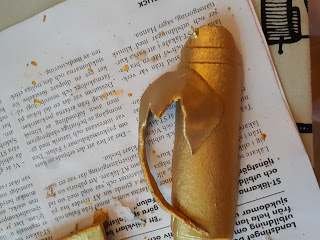Here are a runthrough of how I made the details
First off were the patches and decorations on the sleeves. I added all the details on the sleeves before I sewed them together and onto the main flighsuit, so that I could work on a flat surface.
Daala is wearing two patches. For the first larger patch I first printed the look of it and transfered it to a scrap piece of yellow fabric. I had also added fusible interfacing to the back of the fabric to make it more sturdy. I then outlined the shapes in black embroidery thread, and after that I filled the patch with small satin stitches in yellow. I did not make the two black bars of the patch.
I then cut out the patch
The patch was sewn on to the sleeve with a button hole stitch, using double strands of black embroidery thread, and after that I added the two black bars by hand.
The other smaller patch I embroidered free hand direct onto the fabric
The strips of fabric are bias tape in turquoise and black that I sewed on by machine. Since the fabric is really stretchy I used a fairly large stitch to sew the tape on, so that it can more easily follow the stretching of the fabric.
The last thing to add were the pockets on the legs.
Each pocket and flap are just rectangular pieces of fabric. I've sewed them on with double seams to make them a bit more sturdy. I did add a length of cotton tape both at the opening of the pocket and at the hem of the flap to make it sturdier.
The larger greeblie is attached to the pocket, and I will be able to pull the strap through it to keep the pocket closed.
In order to get a big enough surface to glue to the fabric I added some smaller lumps of worbla until I got two attachment points on each greeblie.
The top greeblie is glued to the strap. I'm pretty sure that it meant to be a clasp that you can pull the strap through, but it was easier to glue it to the strap itself. At the bottom of the strap I have also glued a piece of worbla to make it stiff and easy to pull through the large greeblie.
The last detail is Daala's admiral rank bar. It was made for me by a friend in the Nordic Garrison.
Now it's only to finish the belt and then I'm ready to send in application photos to the 501st Legion.
































